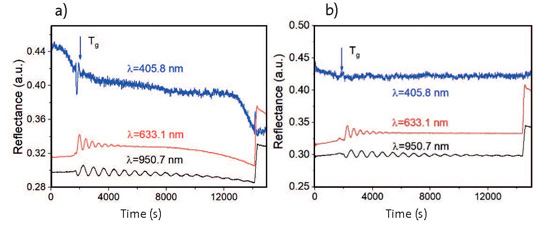News: Suppliers
17 January 2020
LayTec EpiTT used to optimize MBE growth of InP-based quantum cascade lasers
In their recent molecular beam epitaxy (MBE) project, researchers at the Institute of Electron Technology in Warsaw, Poland focused on optimizing the growth conditions of MBE-grown indium phosphide (InP)-based quantum cascade lasers (QCLs) (P. Gutowski et al., ‘Materials 2019’, 12, 1621; doi:10.3390/ma12101621).
For this purpose, their Riber Compact 21T MBE system was equipped with an EpiTT 3W tool from LayTec AG of Berlin, Germany to perform in-situ analysis of the surface morphology and layer thickness. The EpiTT delivers reflectance at 950nm, 633nm and 405nm wavelengths as well as surface temperature.

Figure: EpiTT reflectance traces during growth of 2.5µm-thick InAlAs layers at V/III=12: (a) at Tg=520°C and b) at Tg=480°C (cited from P. Gutowski et al., ‘Materials 2019’, 12, 1621; doi:10.3390/ma12101621).
The Figure demonstrates that reflectance measured by the EpiTT in-situ metrology tool is highly sensitive to defect-driven surface morphology changes during growth of these rather thick waveguide layers, especially at 405nm and 633nm. The in-situ data in (a) show a clear decrease in all three reflctance signals at 520°C growth temperature while (b) verifies that the surface of the waveguide layers stays smooth under optimized growth conditions at 480°C. The QCLs grown using the new recipe have shown lower threshold currents and substantially improved slope efficiency, LayTec notes.








